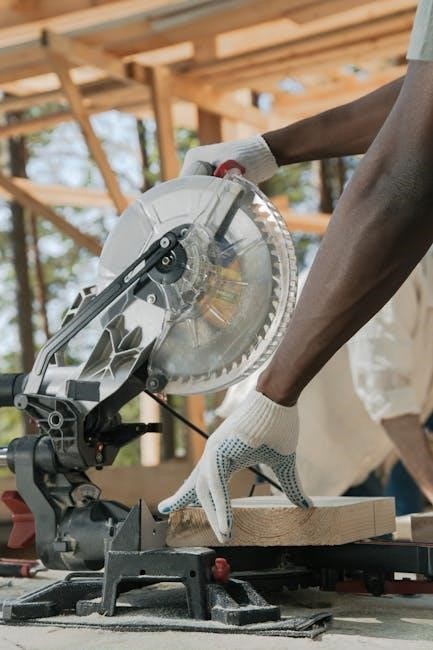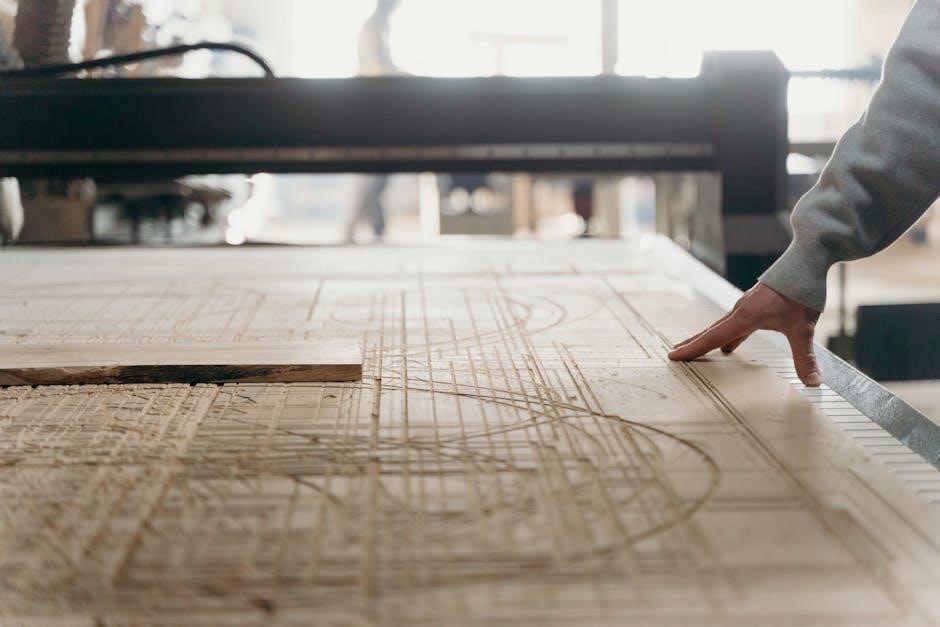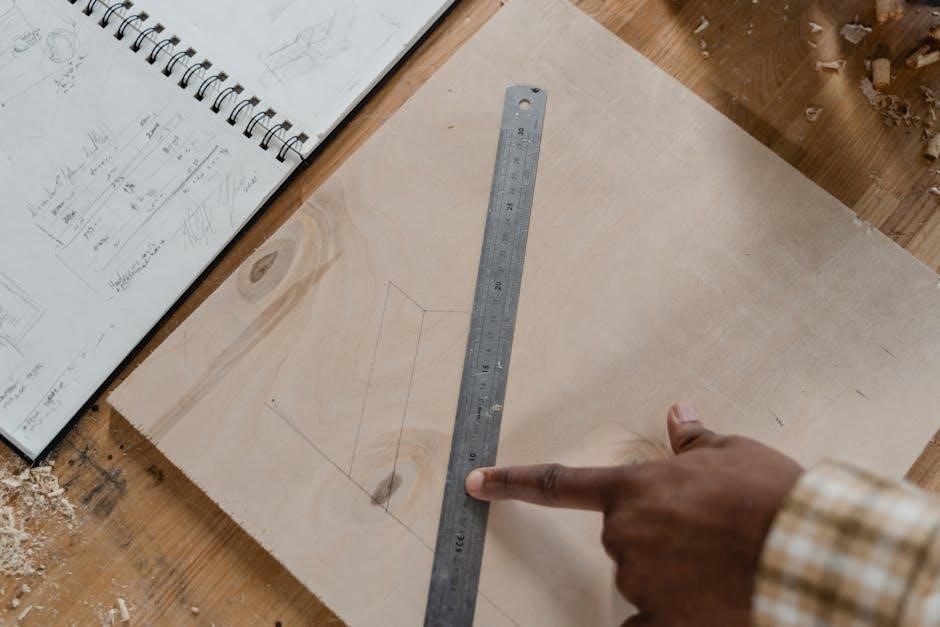The 2018 Wood Frame Construction Manual (WFCM) provides essential guidelines for wood framing construction, ensuring structural integrity and compliance with building codes for safe and durable structures.
1.1. Overview of Wood Framing
The 2018 Wood Frame Construction Manual (WFCM) outlines wood framing as a widely used method in residential and light commercial construction. It offers efficient, cost-effective solutions for building structures. The manual covers engineered and prescriptive design requirements for various elements like lumber, trusses, and I-joists. By adhering to the WFCM, constructions ensure safety and compliance with the International Building Code and Residential Code, making it a vital resource for wood-frame projects.
1.2. Importance of a Construction Manual
A construction manual is crucial for ensuring safety, compliance, and efficiency in wood framing projects. It provides standardized guidelines for design, materials, and assembly, minimizing errors and ensuring structural integrity. By adhering to the manual, builders comply with building codes and industry standards, such as the International Residential Code. It serves as a comprehensive resource for professionals, ensuring best practices are followed, and it aids in achieving durable, long-lasting wood-frame structures.
1.3. Scope and Application of the Manual
The Wood Frame Construction Manual addresses structural design and construction for one- and two-family dwellings, covering framing, connections, and load calculations. It applies to engineered and prescriptive approaches, ensuring compliance with codes like the International Building Code. The manual is a key resource for builders, engineers, and architects, offering detailed guidelines for safe and efficient construction of wood-frame structures.

Materials and Tools for Wood Framing
Key materials include lumber, fasteners, and structural sheathing, while essential tools range from hammers to power saws, ensuring efficient and precise wood framing construction.
2.1. Lumber Types and Grades
Lumber for wood framing includes sawn lumber, structural glued laminated timber, and engineered wood products like I-joists. Grades are determined by strength, stiffness, and appearance, adhering to standards such as PS 20. Proper selection ensures structural integrity and compliance with building codes, as outlined in the WFCM. Lumber must be suitable for load-bearing applications, with specific grades recommended for walls, floors, and roofs to ensure safety and durability in construction projects.
2.2. Fasteners and Connectors
Fasteners and connectors are critical for ensuring structural integrity in wood framing. The WFCM specifies approved fasteners, including nails, screws, and bolts, which must meet ANSI standards. Connectors like joist hangers and truss plates enhance load transfer and stability. Proper selection and installation of these components are essential for complying with building codes and achieving durable, safe wood-frame structures, as detailed in the 2018 WFCM for One- and Two-Family Dwellings.
2.3. Essential Tools for Framing
Essential tools for wood framing include a circular saw for cutting lumber, a drill for pre-drilling holes, and impact drivers for securing fasteners. Tape measures, squares, and levels ensure accurate and precise construction. Safety equipment like hard hats and gloves is also crucial. These tools are fundamental for efficient and safe framing operations, as outlined in guides like the WFCM for achieving professional results in wood-frame construction projects.

Foundation and Site Preparation
Proper site selection and excavation ensure a stable base for wood-frame structures, while level surfaces and compliant foundation requirements guarantee structural integrity and long-term durability.
3.1. Site Selection and Excavation
Site selection involves evaluating land conditions to ensure stability and drainage, while excavation requires precise leveling to prepare the ground for the foundation. Proper site preparation prevents structural issues and ensures compliance with building codes, as outlined in the 2018 WFCM.
3.2. Foundation Requirements for Wood-Frame Structures
Wood-frame structures require robust foundations to ensure stability and load distribution. The 2018 WFCM outlines specific requirements, including proper footer depths, wall construction, and anchorage to prevent settling or damage. Compliance with these standards guarantees a secure base for the entire structure, adhering to both local building codes and engineering best practices.

Design Considerations
Design considerations in wood framing involve load calculations, structural integrity, and adherence to building codes like the IRC, ensuring safe and durable construction practices.
4.1. Load Calculations and Structural Integrity
Load calculations are critical for ensuring structural integrity in wood framing. The WFCM provides design requirements for dead, live, snow, seismic, and wind loads, ensuring compliance with building codes. Proper load distribution and material selection are essential to avoid structural failure. The manual offers engineered solutions to meet specific load conditions, ensuring safe and durable construction practices. Adherence to these guidelines is vital for maintaining the integrity of wood-frame structures under various environmental and operational stresses.
4.2. Building Codes and Compliance
The WFCM ensures compliance with building codes by providing design and construction standards for wood-frame structures. It is referenced in the International Building Code (IBC) and International Residential Code (IRC), ensuring adherence to safety and structural requirements. The manual includes engineered and prescriptive design methods, meeting ANSI standards. Compliance with WFCM guidelines ensures that wood-frame buildings meet local building regulations, promoting safety and durability in construction projects.

Wall Framing
Wall framing involves constructing exterior and interior walls, ensuring structural integrity and proper placement of windows and doors. The WFCM provides guidelines for spacing and connections.
5.1. Constructing Exterior Walls
Constructing exterior walls involves framing with lumber, ensuring proper alignment and structural integrity. The WFCM provides guidelines for load calculations, fastener spacing, and sheathing installation. Weatherproofing measures, such as house wrap and flashing, are essential to prevent moisture damage. Properly spaced studs and headers ensure durability and compliance with building codes. The manual also addresses wall bracing and insulation requirements for energy efficiency and structural stability in exterior wall systems.
5.2. Interior Wall Framing Techniques
Interior wall framing involves constructing non-load-bearing partitions using dimensional lumber. Techniques include assembling studs, tracks, and headers to define room layouts. Proper alignment with floor and ceiling framing is crucial. The WFCM specifies spacing and fastening methods to ensure stability. Soundproofing and insulation requirements are addressed, along with door and window opening framing. Techniques may vary based on design needs, but adherence to manual guidelines ensures structural integrity and compliance with building standards for interior spaces.

Floor Framing
Floor framing involves constructing joists and beams to support loads. The WFCM provides engineered and prescriptive design requirements for wood-frame floors, ensuring structural integrity and safety.
6.1. Joist and Beam Design
Joist and beam design is critical for ensuring structural integrity in floor framing. The 2018 WFCM provides engineered solutions, including load calculations and span tables for various lumber types. Proper sizing of joists and beams ensures floors can safely support dead and live loads, maintaining stability and preventing deflection. Design considerations include material selection, spacing, and connections to meet building code requirements. This section guides professionals in creating durable and code-compliant floor systems for wood-frame structures.
6.2. Subfloor Installation
A well-installed subfloor is essential for a stable and durable wood-frame structure. The 2018 WFCM provides detailed guidelines for subfloor installation, emphasizing proper material selection and placement. Techniques include ensuring the subfloor is level, securely fastened, and adequately spaced to prevent warping or sagging. Moisture protection measures are also critical, with recommendations for barriers and ventilation. Compliance with code requirements ensures the subfloor meets structural and safety standards, providing a reliable base for flooring materials.

Roof Framing
Roof framing involves constructing rafter and truss systems, ensuring proper roof sheathing, and applying weatherproofing techniques as outlined in the WFCM for durable and safe structures.
7.1. Rafter and Truss Systems
Rafter and truss systems are critical components of roof framing, providing structural support and ensuring even load distribution. The 2018 WFCM outlines engineered and prescriptive requirements for these systems, including spacing, sizing, and load-bearing capacities. Rafters, typically spaced 24 inches on center, are designed to support roof loads, while pre-engineered trusses offer efficient and consistent performance. Proper installation ensures compliance with building codes and maintains structural integrity, as specified by the American Wood Council standards.
7.2; Roof Sheathing and Weatherproofing
Road sheathing and weatherproofing are essential for protecting the structure from environmental elements. The 2018 WFCM specifies requirements for wood structural panel sheathing, ensuring durability and weather resistance. Proper installation of sheathing involves securing it to rafters or trusses with galvanized nails. Weatherproofing measures include applying a weather-resistant barrier and installing flashing around roof openings like vents, chimneys, and skylights. This ensures compliance with building codes and maintains structural integrity, as outlined by the American Wood Council standards for safe and durable construction. Proper installation prevents water infiltration and enhances roof performance, complying with local building codes and ensuring long-term structural reliability.

Windows and Doors
Proper framing techniques for windows and doors ensure correct fit and structural integrity, maintaining the building’s strength and ensuring weather-tight seals, essential for durability.
8.1. Framing Openings for Windows
Framing openings for windows requires precise planning to ensure structural integrity and proper fit. Headers and footers must be sized correctly based on load calculations. Rough sill installation ensures a level base, while king studs provide lateral support. Cripple studs are placed above and below the header to maintain frame stability. Proper flashing and weatherproofing are essential to prevent water intrusion. Accurate measurements and alignment ensure windows fit seamlessly, maintaining the building’s weather-tight integrity and structural performance.
8.2. Door Framing and Installation
Door framing involves constructing a stable opening with headers and side studs. Headers transfer loads above the door to adjacent framing. Rough framing includes installing king studs for support. Door frames must be plumb and level to ensure proper door operation. Anchoring systems secure the frame to surrounding structures. Flashing and weatherproofing prevent water damage. Proper alignment and sealing ensure doors function smoothly, maintaining structural integrity and weather-tightness in wood-frame buildings.

Exterior Finishing
Exterior finishing involves installing siding, trim, and weather barriers. Proper installation ensures weather-tightness, enhances appearance, and provides structural durability.
9.1. Installing Siding and Trim
Installing siding and trim is crucial for weatherproofing and aesthetic appeal. Common materials include vinyl, wood, and fiber-cement. Siding must align with studs for secure fastening. Trim adds finishing touches, sealing gaps and enhancing design. Proper installation ensures durability and prevents moisture damage. Follow manufacturer guidelines for specific materials. Inspect for alignment and secure fit to maintain structural integrity and visual appeal. Precision is key for a professional finish.
9.2. Exterior Sheathing and Weather Barriers
Exterior sheathing provides structural support and a nailing base for siding. Weather barriers, like house wraps, protect the frame from moisture. Sheathing materials include plywood, OSB, and rigid foam. Proper installation ensures airtightness and prevents water infiltration. Weather barriers must be sealed at seams and openings. Code compliance is essential for durability and energy efficiency. A well-installed system safeguards the structure from environmental elements, ensuring long-term performance and minimizing maintenance needs. Adhere to manufacturer guidelines for optimal results.

Interior Finishing
Interior finishing involves installing drywall, trim, and finishes, ensuring a smooth surface for painting and final touches. Compliance with building codes is essential for safety and durability.
10.1. Installing Drywall and Interior Trim
Installing drywall and interior trim requires precise measurements and secure fastening to wood framing. Ensure drywall sheets fit snugly on walls and ceilings, screwed firmly into studs. Trim is then added to cover edges and seams, providing a polished finish. Adhere to IRC standards for thickness and fastener spacing to meet safety and structural requirements. Proper installation prevents gaps and ensures durability.
10.2. Finishing Touches for Interior Spaces
Final interior touches include painting, installing flooring, and adding decorative elements to enhance the aesthetic appeal. Ensure all surfaces are smooth and properly sealed, adhering to fire and safety codes. Detailed trim work and moldings complete the interior finish, providing a polished look. Follow guidelines from the Wood Frame Construction Manual to maintain structural integrity while achieving a professional finish. Attention to detail ensures a comfortable and visually appealing living space.
Safety Considerations
Ensure proper use of protective gear, safe tool handling, and adherence to construction codes to minimize risks. Regular inspections and training prevent accidents and ensure compliance with safety standards.
11.1. On-Site Safety Practices
Ensure all workers wear personal protective equipment (PPE), including hard hats, safety glasses, and steel-toe boots. Regularly inspect tools and equipment for damage. Maintain a clean site to prevent tripping hazards. Use proper lifting techniques to avoid injuries. Ensure scaffolding is stable and meets safety standards. Adhere to local building codes and safety regulations. Conduct daily safety briefings and provide training on handling materials and tools safely. Implement emergency response plans for accidents or fires. Always follow manufacturer guidelines for equipment operation.
11.2. Handling Materials Safely
Properly handle lumber and materials to prevent injuries and damage. Use mechanical aids like forklifts or dollies for heavy loads. Ensure materials are securely stored to avoid collapse. Pre-drill wood to prevent splitting during fastening. Use gloves when handling sharp or rough-cut lumber. Inspect materials for defects before use. Train workers on proper lifting techniques to prevent strain. Keep walkways clear to avoid tripping. Follow manufacturer guidelines for fasteners and connectors to ensure structural integrity. Regularly inspect equipment and tools for safe operation.
The Wood Frame Construction Manual provides comprehensive guidelines for safe, durable wood-frame structures, ensuring compliance with building codes and best practices for structural integrity.
12.1. Final Inspection and Completion
The final inspection ensures all wood-frame components meet code requirements and the manual’s standards. Structural integrity, safety, and durability are verified. Proper documentation and approval complete the process, ensuring compliance with building codes and regulations for a secure and long-lasting structure.
12.2. Maintenance and Upkeep
Regular maintenance ensures the longevity of wood-frame structures. Inspections for rot, insect damage, and structural issues are crucial. Weatherproofing and securing fasteners prevent deterioration. Proper upkeep adheres to the Wood Frame Construction Manual’s guidelines, ensuring safety and extending the building’s lifespan while maintaining its integrity and functionality over time.
